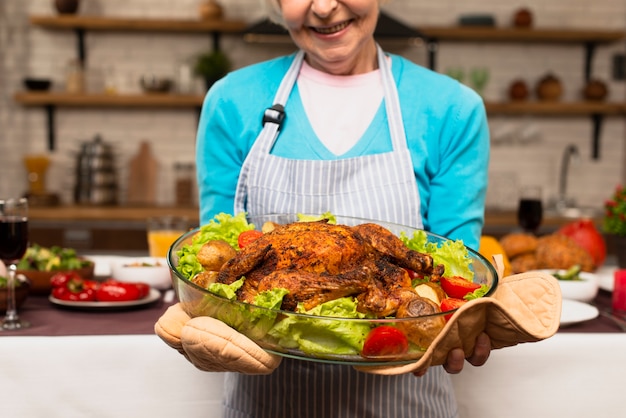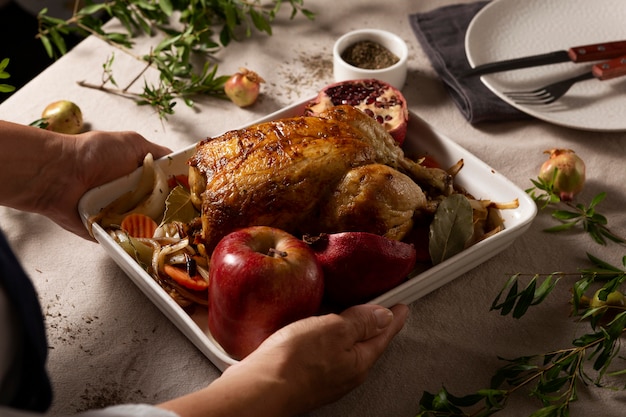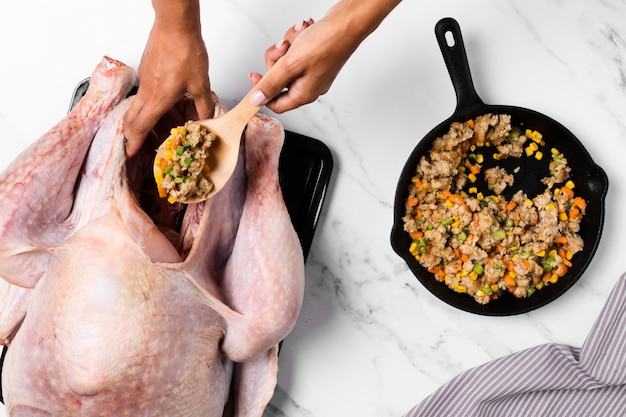The Basics of Chicken Cooking: Temperature is King

Before we get into the specifics, let's nail down the most crucial element: internal temperature. It's the golden standard for knowing if your chicken is safe to eat. You want it to hit 165°F (74°C) throughout. You can use a meat thermometer for that – it's the most accurate way to go. But if you're feeling a bit more adventurous, there's also the "touch test" – though that one takes a bit more practice and experience.
Let's be honest, that thermometer is a lifesaver. I've learned the hard way – undercooked chicken is a recipe for disaster. Remember, the internal temperature is the key to a safe and delicious meal.(Part 2)
Beyond Temperature: Factors Influencing Cooking Times

Now, internal temperature isn't the only factor in the chicken cooking equation. Other things play a significant role in determining how long your bird takes to cook:
- The Cut of Chicken: A whole chicken is going to need a different approach than individual chicken breasts, thighs, or wings. Each cut has its own cooking quirks.
- The Cooking Method: Roasting, grilling, frying, baking – they all have different temperature and time requirements.
- The Size of the chicken pieces: A whole chicken will obviously take longer than individual chicken breasts. A larger bird will also take longer than a smaller one.
- The Thickness of the Chicken: A thick chicken breast will need more time than a thin one to cook through.
- The Oven Temperature: Higher temperatures mean faster cooking, but also a higher risk of dryness. It's a balancing act!
So, remember these factors as we dive deeper into the specifics of different chicken cuts and cooking methods. It's all about finding the right balance for your particular situation.(Part 3)
Understanding Chicken Cuts: A Guide to Your Poultry Pantry

Let's break down the different cuts of chicken so you can get a better handle on how they cook:
Whole Chicken: The Classic Choice
Whole chickens are the big guys. They're usually about 3-4 pounds and are the classic choice for roasting. They're perfect for a Sunday dinner or a special occasion. You can also cut them up into pieces for other cooking methods.
Chicken Breasts: Lean and Versatile
Chicken breasts are the leanest cuts and are incredibly versatile. They're perfect for grilling, pan-frying, or baking. They hold their shape well and are a great base for many dishes.
chicken thighs: Juicy and Flavorful
Chicken thighs are a bit more flavorful and juicy than breasts because they have more fat. They're great for grilling, frying, or braising, and they hold their moisture beautifully.
Chicken Legs: A More Challenging Cut
Chicken legs are essentially the thigh and drumstick combined. They can be a bit more challenging to cook than breasts, but they're worth the effort. The drumstick requires a bit more time to cook through, and they have a lot of flavor.
chicken wings: Snacking Perfection
Chicken wings are a popular snack or appetizer. They're perfect for game day, parties, or just a casual meal. You can fry, grill, or bake them, and there are endless ways to season them.(Part 4)
roasting chicken: A Culinary Classic
Roasting chicken is a classic way to cook a whole chicken, and it's incredibly delicious. It's a bit of a skill, but with some practice, you can create a masterpiece. Here's what you need to know:
roasting time:
A whole chicken, weighing around 3-4 pounds, will typically take about 1 hour and 30 minutes to roast. However, you need to check the internal temperature to be sure it's reached 165°F (74°C) throughout. It's better to overcook it a bit than undercook it. Don't be afraid to go a little longer if needed.
roasting temperature:
Most ovens will recommend a temperature of 350°F (175°C) for roasting chicken. This allows for even cooking throughout.
roasting tips:
- Pat the chicken dry with paper towels before roasting. This will help the skin to crisp up nicely.
- Season the chicken liberally with salt and pepper. You can also add other herbs and spices for extra flavour. I like to use a blend of rosemary, thyme, and garlic.
- Place the chicken in a roasting pan and roast for about 1 hour and 30 minutes, or until the internal temperature reaches 165°F (74°C).
- Basting the chicken with pan juices during the last 30 minutes of cooking will help keep it moist.
- Let the chicken rest for 10-15 minutes before carving and serving. This will allow the juices to redistribute and make the meat even more tender.
Remember, the timing is a guideline, and you might need to adjust it based on your oven and the size of the chicken. (Part 5)
grilling chicken: A Summertime Favourite
Grilling chicken is a fantastic way to enjoy those warm summer evenings. It adds a nice smoky flavour, and it's relatively quick. It's a great way to showcase the fresh flavours of summer.
Grilling Time:
Chicken breasts will take about 5-7 minutes per side, while chicken thighs will take about 8-10 minutes per side.
Grilling Temperature:
A medium-high heat (about 400°F or 200°C) is ideal for grilling chicken.
grilling tips:
- Make sure the grill grates are clean and oiled to prevent sticking.
- Season the chicken generously with salt, pepper, and any other herbs or spices you like. For a simple and flavorful marinade, try a mixture of olive oil, lemon juice, garlic, and herbs.
- Place the chicken on the hot grill and cook for about 5-7 minutes per side for breasts, or 8-10 minutes per side for thighs.
- Flip the chicken halfway through cooking to ensure even browning.
- Use a meat thermometer to check the internal temperature, which should be 165°F (74°C) for chicken breasts and thighs.
Remember, grill times can vary depending on the thickness of the chicken and the heat of your grill.(Part 6)
pan-frying chicken: A Quick and Easy Weeknight Solution
Pan-frying chicken is a quick and easy way to cook chicken. It's perfect for a weeknight meal when you're short on time. You can have a delicious chicken dinner on the table in less than 30 minutes.
Pan-Frying Time:
Chicken breasts will take about 4-6 minutes per side, while chicken thighs will take about 6-8 minutes per side.
Pan-Frying Temperature:
Use a medium-high heat (about 375°F or 190°C) for pan-frying chicken.
Pan-Frying Tips:
- Heat a tablespoon of oil in a large skillet over medium-high heat.
- Season the chicken generously with salt, pepper, and any other herbs or spices you like. I love to use a blend of paprika, garlic powder, and onion powder.
- Place the chicken in the hot skillet and cook for about 4-6 minutes per side for breasts, or 6-8 minutes per side for thighs.
- Flip the chicken halfway through cooking to ensure even browning.
- Use a meat thermometer to check the internal temperature, which should be 165°F (74°C) for chicken breasts and thighs.
Remember, pan-frying times can vary depending on the thickness of the chicken and the heat of your skillet.(Part 7)
baking chicken: Simplicity and Versatility
Baking chicken is a great way to cook it in the oven without needing to keep a watchful eye on it. It's a simple method that gives you great results.
Baking Time:
Chicken breasts will take about 20-25 minutes to bake, while chicken thighs will take about 30-35 minutes.
Baking Temperature:
A medium oven (about 350°F or 175°C) is ideal for baking chicken.
baking tips:
- Preheat your oven to 350°F (175°C).
- Line a baking sheet with parchment paper or aluminum foil for easy cleanup.
- Season the chicken generously with salt, pepper, and any other herbs or spices you like.
- Place the chicken on the prepared baking sheet and bake for about 20-25 minutes for breasts, or 30-35 minutes for thighs.
- Use a meat thermometer to check the internal temperature, which should be 165°F (74°C) for chicken breasts and thighs.
Remember, baking times can vary depending on the thickness of the chicken and your oven.(Part 8)
cooking chicken Wings: A Snacking Masterpiece
Ah, chicken wings. The ultimate snack food. Whether you're watching a game, having a party, or just enjoying a casual meal, they're always a crowd-pleaser.
Cooking Time:
Chicken wings take around 30-40 minutes to cook.
Cooking Temperature:
The oven is the most versatile method, with a temperature of 400°F (200°C) being ideal.
cooking tips:
- Preheat your oven to 400°F (200°C).
- Pat the chicken wings dry with paper towels and toss them with your favourite seasoning blend. You can get creative with the seasonings – try a spicy blend, a sweet and tangy glaze, or even a dry rub.
- Arrange the wings in a single layer on a baking sheet and bake for about 30-40 minutes.
- Flip the wings halfway through cooking to ensure even browning.
- Check the internal temperature, which should reach 165°F (74°C) for the wings to be fully cooked.
Understanding Chicken Cook Time Charts: A Helpful Guide
Now, you might be wondering about those handy-dandy chicken cooking time charts. They can be really helpful, but it's important to remember that they're just a guideline.
Here's a basic chart to give you a rough idea of cooking times for various chicken cuts and methods:
| Chicken Cut | Cooking Method | Cooking Time | Oven Temperature |
|---|---|---|---|
| Whole Chicken (3-4 lbs) | Roast | 1 hour 30 minutes | 350°F (175°C) |
| Chicken Breast (bone-in) | Bake | 20-25 minutes | 350°F (175°C) |
| Chicken Breast (boneless) | Bake | 15-20 minutes | 350°F (175°C) |
| Chicken Thigh (bone-in) | Bake | 30-35 minutes | 350°F (175°C) |
| Chicken Thigh (boneless) | Bake | 20-25 minutes | 350°F (175°C) |
| Chicken Wings | Bake | 30-40 minutes | 400°F (200°C) |
These times are just estimations. Always use a meat thermometer to ensure your chicken is cooked through to 165°F (74°C).(Part 10)
FAQs: Your Chicken Cooking Questions Answered
Let's tackle some of the most common questions you might have about cooking chicken:
1. How do I know when chicken is cooked through?
The best way to tell if chicken is cooked through is to use a meat thermometer. Stick the thermometer into the thickest part of the chicken, making sure not to touch the bone. The temperature should reach 165°F (74°C) for it to be safe to eat.
2. Can I cook chicken on low heat?
You can cook chicken on low heat, but it will take longer. It's better to use a higher heat to get the chicken crispy and brown. If you do cook on low heat, make sure to monitor the temperature carefully and ensure the chicken reaches the correct internal temperature.
3. How can I prevent chicken from being dry?
To prevent chicken from drying out, keep these tips in mind:
- Don't overcook the chicken. Overcooked chicken is dry chicken.
- Use a higher cooking temperature to sear the chicken quickly, creating a flavorful crust.
- Baste the chicken with pan juices or a marinade during cooking. This adds moisture and flavour.
- Let the chicken rest for 10-15 minutes before carving. This allows the juices to redistribute and make the meat even more tender.
4. How long can I cook chicken?
The cooking time for chicken will vary depending on the cut, the method, and the thickness of the meat. It's best to use a meat thermometer to check the internal temperature. Once it reaches 165°F (74°C), it's safe to eat.
5. What are some good ways to use leftover chicken?
Leftover chicken is a fantastic base for all sorts of dishes. You can use it in salads, soups, sandwiches, wraps, or even stir-fries. It's a great way to stretch your meals and prevent food waste. I love making chicken salad sandwiches or adding leftover chicken to a hearty soup. (Part 11)
Final Thoughts on Chicken Cooking: Embrace the Journey
So there you have it, folks. Chicken cooking times and techniques demystified. With a little practice and the right guidance, you'll be whipping up delicious and safe chicken dishes in no time. Remember, it's all about finding what works best for you and your kitchen. Experiment, explore different recipes, and have fun with it! After all, a good chicken dinner is always a winner.
Remember, cooking chicken is a journey, not a destination. Embrace the process, learn from your mistakes, and have fun along the way!
Everyone is watching

Corn on the Cob: The Ultimate Guide to Perfectly Cooked Ears
Healthy MealsAh, corn on the cob. Just the name evokes images of sunny days, barbecues, and that sweet, juicy flavour that ...

Perfect Pork Roast Oven Cooking Time: A Guide to Delicious Results
Healthy MealsThere's something truly satisfying about a perfectly roasted pork. The aroma alone is enough to make your mout...

Ham Cooking Time: How Long to Bake, Smoke, or Boil a Delicious Ham
Healthy MealsAh, ham. It's a classic, isn't it? A real crowd-pleaser, especially around holidays. And when done right, it'...

Scallops: The Ultimate Guide to Perfect Cooking
Healthy MealsAh, scallops. Those delicate, sweet, and utterly delicious morsels of the sea. They hold a special place in my...

Spaghetti Squash: The Ultimate Guide to Cooking and Serving
Healthy MealsRemember that time you saw spaghetti squash at the supermarket, looking all bumpy and strange, and thought, "W...
